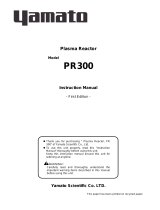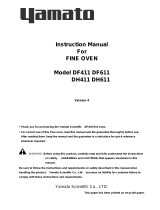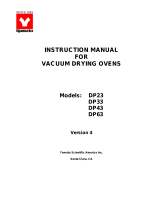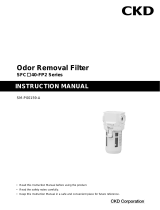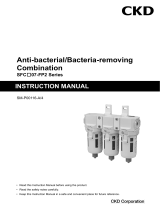Page is loading ...

Plasma Reactor
Model
PR500
Instruction Manual
- First Edition -
Yamato Scientific Co. LTD.
This paper has been printed on recycled paper.
z Thank you for purchasing " Plasma Reactor, PR
500" of Yamato Scientific Co., Ltd.
z To use this unit properly, read this "Instruction
Manual" thoroughly before using this unit.
Keep this instruction manual around this unit for
referring at anytime.
WARNING!:
Carefully read and thoroughly understand the
important warning items described in this manual
before using this unit.


Contents
Cautions in Using with Safety................................................................1
• Explanation....................................................................................................................1
• Table of Illustrated Symbols ..........................................................................................2
• Fundamental Matters of “WARNING!” and “CAUTION!”...............................................3
Before Using this unit.............................................................................4
• Requirements for Installation.........................................................................................4
Description and Function of Each Part.................................................7
• Main Unit.......................................................................................................................7
• Control Panel.................................................................................................................8
Installation Method................................................................................10
• Cable tube connection.................................................................................................10
• Principle of operation................................................................................................... 11
• Preparation for operation.............................................................................................12
Operation Method .................................................................................14
•
Operation Procedure...................................................................................................14
Handling Precautions ...........................................................................18
Maintenance Method.............................................................................20
• Daily Inspection and Maintenance ..............................................................................20
Long storage and disposal...................................................................21
• When not using this unit for long term / When disposing............................................21
In the Event of Failure….......................................................................22
After Service and Warranty ..................................................................23
Specification..........................................................................................24
Wiring Diagram......................................................................................25
Replacement Parts Table......................................................................26
Reference...............................................................................................27
•
List of Dangerous Substances ....................................................................................27

1
Cautions in Using with Safety
Explanation
MEANING OF ILLUSTRATED SYMBOLS
Various symbols are used in this safety manual in order to use the unit without
danger of injury and damage of the unit. A list of problems caused by ignoring
the warnings and improper handling is divided as shown below.Be sure that you
understand the warnings and cautions in this manual before operating the unit.
WARNING!
If the warning is ignored, there is the danger of a problem that
may cause a serious accident or even fatality.
CAUTION!
If the caution is ignored, there is the danger of a problem that may
cause injury/damage to property or the unit itself.
Meaning of Symbols
This symbol indicates items that urge the warning (including the caution).
A detailed warning message is shown adjacent to the symbol.
This symbol indicates items that are strictly prohibited.
A detailed message is shown adjacent to the symbol with specific actions not to
perform.
This symbol indicates items that should be always performed.
A detailed message with instructions is shown adjacent to the symbol.
Illustrated Symbols

2
Cautions in Using with Safety
Table of Illustrated Symbols
Warning
Warning,
generally
Warning,
high voltage
Warning,
high temperature
Warning,
drive train
Warning,
explosive
Caution
Caution,
generally
Caution,
electrical shock
Caution,
scald
Caution,
no road heating
Caution,
not to drench
Caution,
water only
Caution,
deadly poison
Prohibit
Prohibit,
generally
Prohibit,
inflammable
Prohibit,
to disassemble
Prohibit,
to touch
Compulsion
Compulsion,
generally
Compulsion,
connect to the
grounding
terminal
Compulsion,
install on a flat
surface
Compulsion,
disconnect the
power plug
Compulsion,
periodical
inspection

3
Cautions in Using with Safety
Fundamental Matters of “WARNING!” and “CAUTION!”
WARNING!
Do not use this unit in an area where there is flammable or explosive gas
Never use this unit in an area where there is flammable or explosive gas.
This unit is not explosion-proof. An arc may be generated when the power switch is turned on or off,
and fire/explosion may result. (Refer to page27 “List of Dangerous Substances”.)
Always ground this unit
Always ground this unit on the power equipment side in order to avoid electrical shock due to a power
surge.
If a problem occurs
If smoke or strange odor should come out of this unit for some reason, turn off the power key right
away, and then turn off the breaker and the main power. Immediately contact a service technician for
inspection. If this procedure is not followed, fire or electrical shock may result. Never perform repair
work yourself, since it is dangerous and not recommended.
Do not use the power cord if it is bundled or tangled
Do not use the power cord if it is bundled or tangled. If it is used in this manner, it can overheat and
fire may be caused.
Do not process, bend, wring, or stretch the power cord forcibly
Do not process, bend, wring, or stretch the power cord forcibly. Fire or electrical shock may result.
Substances that can not be used
Never use explosive substances, flammable substances and substances that include explosive or
flammable ingredients in this unit. Explosion or fire may occur.
Do not disassemble or modify this unit
Do not disassemble or modify this unit. Fire or electrical shock or failure may be caused.
CAUTION!
During a thunder storm
During a thunderstorm, turn off the power key immediately, then turn off the breaker and the main
power. If this procedure is not followed, fire or electrical shock may be caused.

4
Before Using this unit
Requirements for Installation
WARNING!
1. Always ground this unit
• Connect the power plug to a receptacle with grounding connectors.
• Do not forget to ground this unit, to protect you and the unit from electrical shock in case of
power surge. Choose a receptacle with grounding connectors as often as possible.
• Do not connect the grounding wire to a gas pipe, or by means of a lightning rod or telephone
line. A fire or electrical shock will occur.
2. Choose a proper place for installation
• Do not install this unit in a place where:
♦ Rough or dirty surface.
♦ Flammable gas or corrosive gas is generated.
♦ Ambient temperature exceeds 35°C.
♦ Ambient temperature fluctuates violently.
♦ There is direct sunlight.
♦ There is excessive humidity and dust.
♦ There is a constant vibration.
• Install this unit on a stable place with the space as shown below.
Main Unit
More than
60cm
More than
60cm
More than 100cm
More than 100cm
3. Do not use this unit in an area where there is flammable or explosive gas
• Never use this unit in an area where there is
flammable or explosive gas. This unit is not
explosion-proof. An arc may be generated
when the power switch is turned ON or OFF,
and fire/explosion may result.

5
Before Using this unit
Requirements for Installation
4. Do not modify
• Modification of this unit is strictly prohibited.
This could cause a failure.
5. Installation on horizontal surface
• Set this unit to the flattest place. Setting this unit on rough or slope place could cause the
vibration or noise, or cause the unexpectible trouble or malfunction.

6
Before Using this unit
Requirements for Installation
CAUTION!
6. Choose a correct power distribution board or receptacle
• Choose a correct power distribution board or receptacle that meets the unit’s rated electric
capacity.
Electric capacity: 100V AC, 15A
NOTE)
There could be the case that the unit does not run even after turning ON the power. Inspect
whether the voltage of the main power is lowered than the specified value, or whether other
device(s) uses the same power line of this unit. If the phenomena might be found, change the
power line of this unit to the other power line.
7. Before/after installing
• It may cause injure to a person if this unit falls down or moves by the earthquake and the
impact. etc..To prevent, take measures that the unit cannot fall down, and not install to busy
place.
• Touching the unit may cause a burn during and just after the operation. To prevent, take
measures that putting up a notice of operating etc..
8. Connection to vacuum pump
• Use the vacuum pump with the displacement of 250 to 500 /min.

7
Description and Function of Each Part
Main Unit
Front view
Rear view
Door handle
Inspection window
Production plate
Front grill
Power cord
Control panel
Vacuum pump
connecting port
Purge gas connector
Vacuum pump connector
PUMP power source connector
GAS 2 connector
GAS 1connector
Cooling fan

8
Description and Function of Each Part
Control Panel
TIMESET
OUTPUT ← TIMER PUMP POWER
MAIN
GAS 1
ON
OFF
GAS2
ON
OF F
VACUUM
OPEN OPENCLOSE CLOSE
LOC AL
REMOTE
FORWARD REFLECT
POWERSET
① Main Switch:
Switches the main power supply and functions as a circuit protector, too.
When over current is detected, it turns off the power supply.
② Power Switch:
Starts to operate cooling fan when it is turned on. The lamps light on. The
solenoid valve for leak is also turned on.
③ Pump Switch:
The switch to drive the vacuum pump. The pump starts to operate when
this switch is turned on. At the same time the solenoid valve for leak is
turned off. The lamp lights on.
④ Timer Switch:
Used to apply high-frequency power for definite period of time. Normally
turn the switch to OFF. The lamp lights on when the switch is turned to ON.
⑤ Ready Lamp:
Lights on after one and a half minute has passed since the pump switch ON.
The output switch is possible to be set to ON after the lamp lights on.
⑥ Output Switch:
ON/OFF switch for high-frequency power. The lamp lights on when this
switch is turned to ON
⑦ Gas Valve 1 (CF
4
) Switch:
ON/OFF switch for solenoid valve for supplying CF
4
gas.
⑧ Gas Valve 2 (O
2
) switch:
ON/OFF switch for solenoid valve for supplying O
2
gas.
⑨ Flow Meter (O
2
):
Indicates the flow rate of O
2
gas inside the reaction tune.
⑩ Needle Valve Knob (O
2
):
Adjusts the flow rate of gas that is taken into the reaction tube while
monitoring ⑧ above.
⑪ Flow Meter (CF
4
):
Indicates the flow rate of CF
4
gas inside the reaction tune.
⑫ Needle Valve Knob (CF
4
):
Adjusts the flow rate of gas that is taken into the reaction tube while
monitoring ⑫ above.
⑬ Vacuum Meter
(Refer to Page 9.):
Indicates the pressure inside reaction tube by Pa (0~200).
⑫
⑬
⑥ ⑤
⑰ ④
③
②
①
⑮
⑯
⑭
⑱
⑦
⑨
⑩
⑪
⑧

9
Description and Function of Each Part
Control Panel
⑭ Output Power Knob:
Indicates the output power (0 to 500W).
⑮ Reflected Power Meter: Indicates the reflected power to the output in ⑭.
⑯ Output Control Valve:
Controls the output power within the range from 0 to 500 watts.
⑰ Timer:
Sets the timer of high-frequency applying period.
⑱ Power Switch for
High-frequency
Power Source:
The power is on at PF ON.
The power is off at RF OFF.
Normally use this switch at ON.
Enlarged View of Vacuum Meter
SP1 SP2
Pa
1
0
5
10
20
30
40
50
100
200
ATM
1
/
4
2
/
4
3
/
4
SP1 SP2
Pa
1
0
5
10
20
30
40
50
100
200
ATM
1
/
4
2
/
4
3
/
4
① Scale LED
Scale displays of the Pa output state with the LED lamp
② Auxiliary Scale Displays the output state between memories in ① (LED lamp) by 1/4, 2/4
and 3/4.
③ Pressure Set Point Output
Corresponds with custom-build specifications only.
It can not be used in the standard specification.
①
②
③

10
Installation Method
Cable tube connection
• Connect the cable tube
according to the right figure.
• Refer to the connection of
vacuum pump and gas piping
for the page 12.
The parts enclosed with the
dotted line indicate optional
accessories.
PUMP
電源
PUMP
GAS2
GAS1
GROUND
Piping System View
Purge gas
connector
100V AC
single phase
PUMP
power
source

11
Installation Method
Principle of operation
(Refer to the operation flow chart below.)
The controller supplies the high-frequency power of 13.56MHz generated by crystal
oscillation to the reaction section. The output range is from 0 to 500W that can be set to
desired value with the wattmeter attached.
Two kinds of gas, O
2
(30~300m
λ
/min) and CF
2
(10~100m
λ
/min) can be supplied to the
reaction tube with the flow meter. The flow rate can be set to desired value.
The gas is changed into plasma by high-frequency energy applied to the high-frequency
supplying electrode.
The gas exhaust is carried out through the main valve on vacuum meter, bypass, and leak
valve. Turning the pump switch to ON starts pressure reduction through the bypass. After
around 1 minetes, the main valve opens to increase the reduction speed.
Turning the pump to OFF closes the main valve and opens the leak valve. The pressure in
the reaction tube is intensified to normal pressure.
Operation flow chart
MAIN
Switch ON
POWER
Switch ON
PUMP
Switch ON
Preliminary
Pressure
Reduction
Evacuation
READY
Lamp
Lights
CAS Switch ON
CAS Valve Open
OUT PUT
Switch ON
OUT PUT
Switch OFF
CAS Switch OFF
CAS Valve Close
PUMP Switch
OFF
Normal
Pressure
End
T
Reaction
Leak Gas
Leak Valve
Close
Leak Valve
Open

12
Installation Method
Preparation for operation
Connection to vacuum pump
Use the vacuum pump with the displacement of 250~500
λ
/min (5A or below).
A NW 25 flange type is used to connect the unit and vacuum pump. In case a vacuum hose
is used for connection, a rubber tube adapter, center ring and clamp are needed.
Attaching an oil mist eliminator such as a trap at the exhaust opening of vacuum pump
prevents smoke. When vacuuming the reaction by CF
4
, mix it with N
2
gas to exhaust, or
make a clearance of 0.5 to 1m between the oil mist eliminator and pump to prevent corrosion.
Exhaust gas should be exhausted outside room (hoses are not attached.).
Relays for pump are inside the unit. Wire connect to the metal connector attached referring
to the figure below for the connection to pump
③②①③②①
The numbers in circles indicate
the pin number of socket.
Inside unit
PUMP(LOAD) 5A or less
100/200V AC
single phase
Rated carrying current for pump relay
200V
three phases
Note: Pump cable is optional.
Gas piping
The gas inlet uses 1/4” swage lock. Prepare the tube with outer diameter of 1/4” for
connection. The types of gas used in the unit are O
2
and F
4
. Prepare the gas container
with capacity of 1.5 to 7m
3.
The gas container with dual pressure adjuster is useful.
Adjust the secondary pressure to 1Kg/㎝
2
if
used.
Before using the gas other than O
2
, check its properties and understand them. Make sure to
connect the exhaust gas hose when using harmful gas.

13
Installation Method
Preparation for operation
Sample setting
1. Place the samples on the sample tray so they are placed evenly as possible. Use the well-dried
samples. If they contain much moisture or are wet, the vacuum degree becomes unstable, that
may result in tuning failure(sample tray: optional accessory).
2. Push the front door at the top of handgrip to open it. Put the sample tray in the reaction
chamber.
3. Apply attached silicon grease on the O ring at reaction tube. Fit the ring into the groove on the
reaction tube. Do not apply too much grease on the ring. It may be removed from the groove.
4. Cover the cap on reaction tube and then close the door.
There is a possibility that silicone grease may enter into the reaction tube.
Groove
Reaction Tube
O-ring (Apply grease and fit it into the groove.)
Reaction tube cover
Door
Top View with Door Opened
Open/Close

14
Operation Method
Operation Procedure
Check the followings before starting operation.
Turn all switches and knobs to “OFF”, “MIN” or “CLOSE”.
The ground of unit is surely connected.
Gas piping is provided from the gas container to the inlet of O
2
or CF
4
gas. Adjust its
secondary pressure to 1Kg/
㎝
2.
Check that the power source to be used complies with specification of vacuum pump.
Connect the power source of unit to 100VAC (50/60Hz).
1) Operation start
1. Turn the MAIN switch to ON.
TIMESET
OUTPUT ← TIMER PUMP POWER
MAIN
GAS 1
ON
OFF
GAS2
ON
OF F
VACUUM
OPEN OPENCLOSE CLOSE
LOCAL
REMOTE
FORWARD REFLECT
POWERSET
2. The lamp lights on and the cooling fan starts to
operate as the POWER switch is turned to ON.
The solenoid valve for leak is turned to ON, too.
TIMESET
OUTPUT ← TIMER PUMP POWER
MAIN
GAS 1
ON
OFF
GAS2
ON
OF F
VACUUM
OPEN OPENCLOSE CLOSE
LOC AL
REMOTE
FORWARD REFLECT
POWERSET
3. Evacuation starts and the lamp lights on as the
PUMP switch is turned to ON. Pressure
reduction is carried out at the glass capillary
first, and then inside the reaction tube. After
around one minutes, the main valve opens and
reduction speed increase. After two minute,
the yellow ready lamp lights on, where the
OUTPUT switch is possible to be turned to ON.
NOTE) In normal condition, the indicating needle on
the vacuum meter swings as the PUMP switch
is turned to ON. If the O-ring and cover on
the reaction tube do not contact closely, it
does not swing. In this case open the door
and check that if the O-ring is fitted securely in
the groove. If removed, apply grease on the
ring and fit it to the groove again.
TIMESET
OUTPUT ← TIMER PUMP POWER
MAIN
GAS 1
ON
OFF
GAS2
ON
OF F
VACUUM
OPEN OPENCLOSE CLOSE
LOC AL
REMOTE
FORWARD REFLECT
POWERSET

15
Operation Method
Operation Procedure
2) Generation of plasma
1. After the yellow ready lamp lights on,
check that the vacuum meter reads 10Pa
or less with the gas valve switch turned to
OFF. Turn the gas valve switch to ON
and needle valve knob to OPEN to adjust
the flow rate (around 1/3 of output).
300W
→ 100cc
200W
→ 70cc
100W
→ 30cc
NOTE) When a vacuum pump with low
displacement is used, an area with low
degree of vacuum exists though the
ready lamp lights on. Please wait until
it becomes 10 Pa or less.
TIMESET
OUTPUT ← TIMER PUMP POWER
MAIN
GAS 1
ON
OFF
GAS2
ON
OF F
VACUUM
OPEN OPENCLOSE CLOSE
LOCAL
REMOTE
FORWARD REFLECT
POWERSET
2. Turn the red OUTPUT switch to ON and
generally turn the output control knob to
MAX side. Set desired output with the
FORWARD POWER meter.
TIMESET
OUTPUT ← TIMER PUMP POWER
MAIN
GAS 1
ON
OFF
GAS2
ON
OF F
VACUUM
OPEN OPENCLOSE CLOSE
LOC AL
REMOTE
FORWARD REFLECT
POWERSET
3. Timer
To apply high-frequency power for the definite period of time, set the desired period by setting the
timer. Press the unit selector switch on the right edge to select the desired unit to be edited
(hour/minute/second). Enter the numeric value with the switch. Turn the TIMER switch to ON after
the setting is completed.
TIME SET
+
+
+
+
---
-
Press the unit selector switch to change the unit to be edited.
It changes in the odder of “0.1s
→s→0.1m→m→0.1h→h→10h”.
②
①
Unit selector switch (hour/minute/second)

16
Operation Method
Operation Procedure
3) Sample unloading
The power of unit is turned to OFF and both the OUTPUT and ready lamps light off when the
time is over if used.
The switches for vacuum pump and gas valve, however, remain to ON. Turn them to OFF and
stop supplying gas before unloading the sample. The unloading procedures are as follows;
1. Turn the output control knob (OUTPUT)
fully to the MIN and turn the OUTPUT
switch to OFF.
TIMESET
OUTPUT ← TIMER PUMP POWER
MAIN
GAS 1
ON
OFF
GAS2
ON
OF F
VACUUM
OPEN OPENCLOSE CLOSE
LOCAL
REMOTE
FORWARD REFLECT
POWERSET
2. Turn the TIMER switch to OFF if used.
3. Turn the needle valve fully to CLOSE. Do
not turn it too hard because the needle
may be broken. Turn the gas valve
switch to OFF.
TIMESET
OUTPUT ← TIMER PUMP POWER
MAIN
GAS 1
ON
OFF
GAS2
ON
OF F
VACUUM
OPEN OPENCLOSE CLOSE
LOC AL
REMOTE
FORWARD REFLECT
POWERSET
②
①
①
②

17
Operation Method
Operation Procedure
4. Turn the PUMP switch to OFF. The leak
valve opens to reduce the pressure in the
reaction tube to normal in two minutes.
5. After the pressure in the reaction tube is
returned to normal, open the door of unit
and unload the samples per carrier with
tweezers. Be careful not to burn your
skin because the temperature inside the
unit is so high.
Be careful not to burn your skin because the temperature inside the unit is so high. Close
the door after unloading the samples.
6. To treat other samples continuously, repeat the operation above. To end the operation, turn the
POWER and MAIN switches to OFF.
4) Sample treatment
1. Treatment methods
• Removal of photo resist (O
2
gas is used)
• Etching of SiO
2
and SiN
4
(CF
2
gas is used)
• Surface treatment of polymer resin such as plastic (O
2
gas is used)
• Surface cleaning of material (O
2
, N
2
and CO
2
gas is used)
• Low temperature ashing of organic matter (O
2
gas is used)
2. Treatment conditions
The rate used for the removal of photo resist or etching of SiO
2
and SiN
4
varies with the following
factors. Find the optimum conditions by conducting experiments.
• RF output, flow rate of gas and degree of vacuum in the reaction tube (pump displacement)
• The number of wafer, its size, loading interval, and loading position in the reaction tube.
• Difference in generation of SiO
2
and Si
3
N
4
and area
• Photo resist type, application thickness and baking temperature
The unit door is not open if the POWER switch is turned to OFF before the pressure inside
the reaction tube completes to return to normal pressure because of the vacuum condition
inside the tube. It may be broken if opened by force. In this case, turn the POWER switch
to ON again and completely return the vacuumed pressure inside the tube to normal.
/
